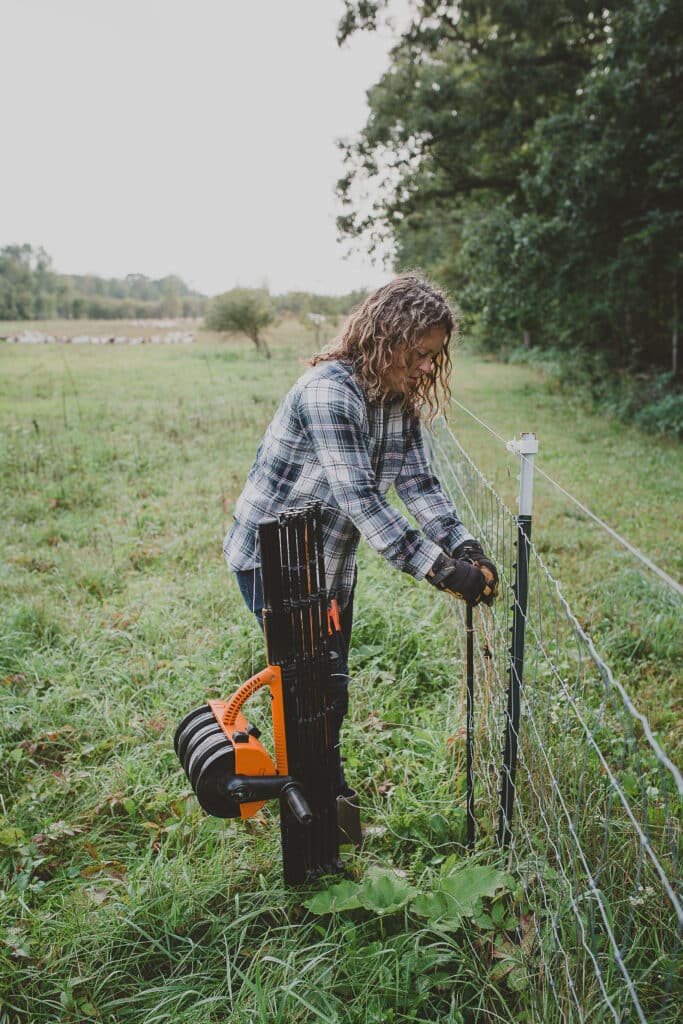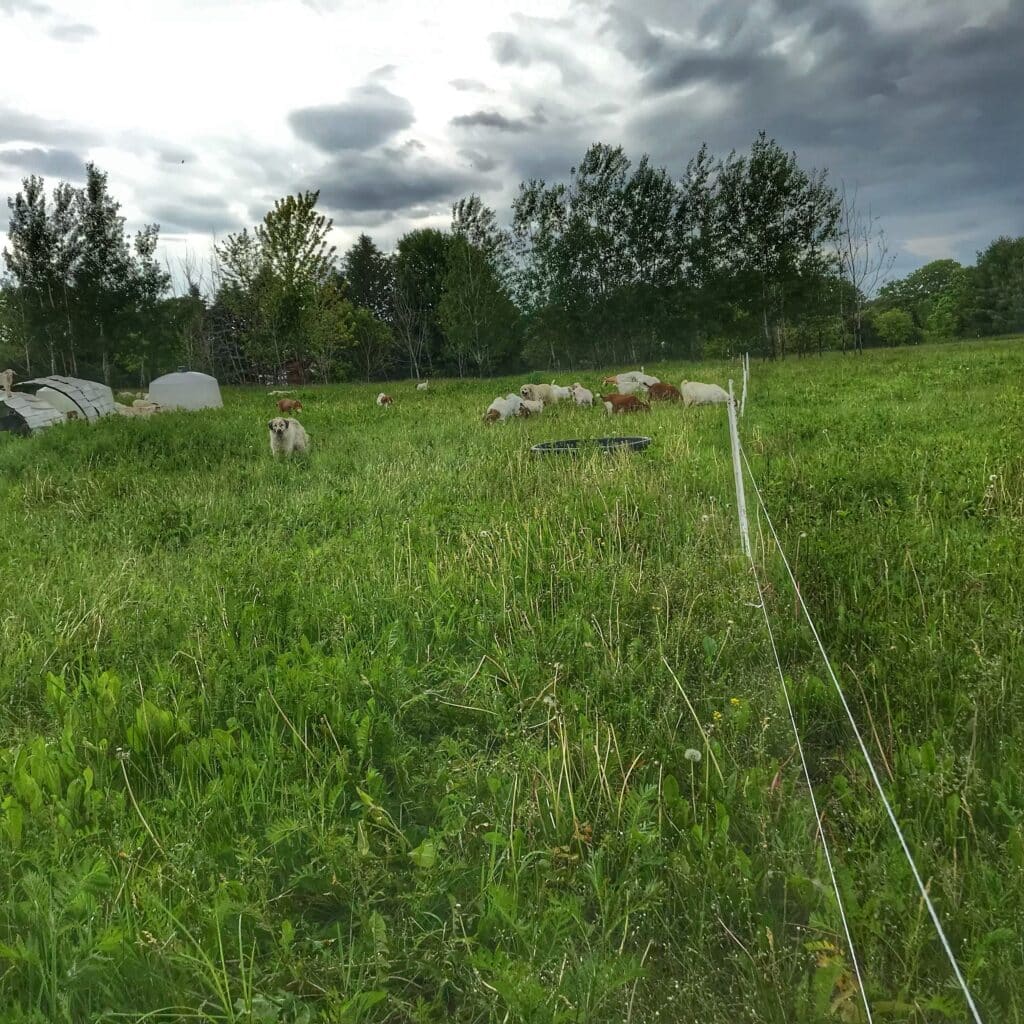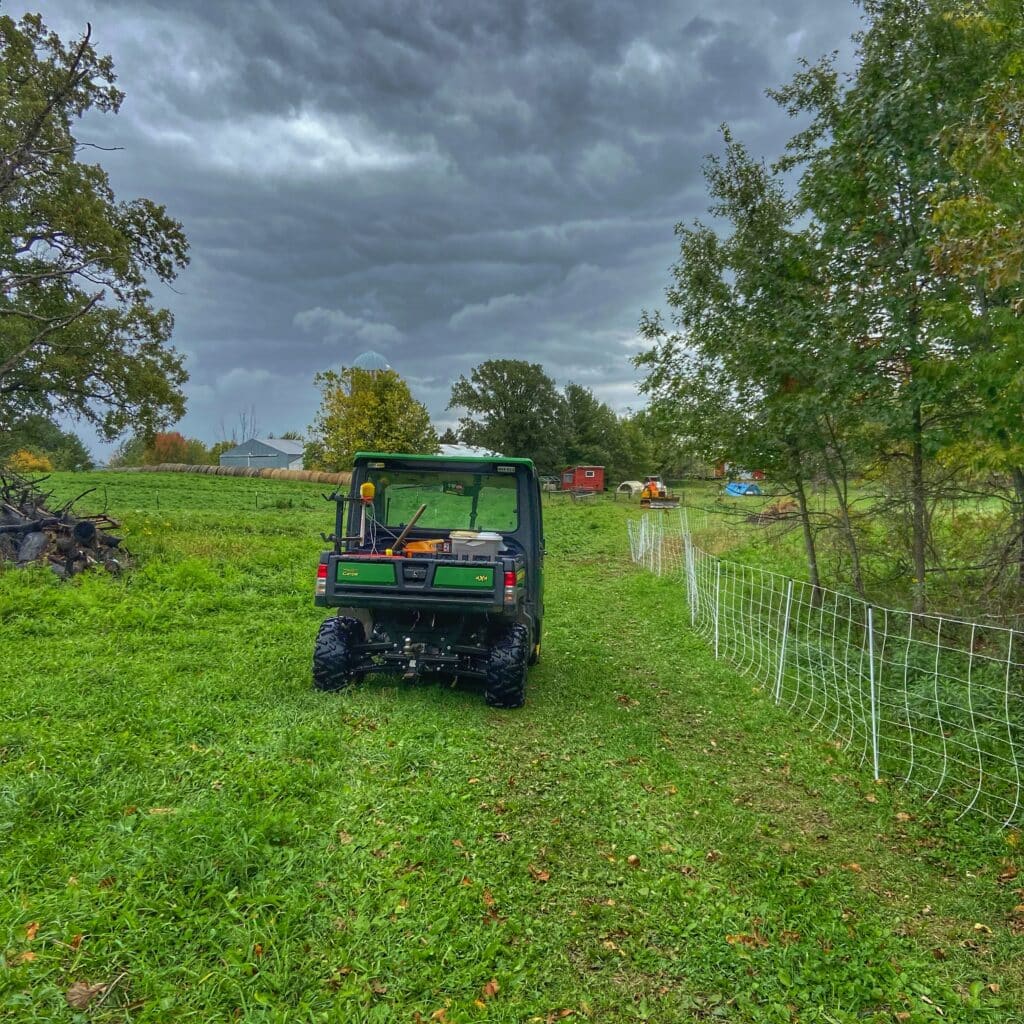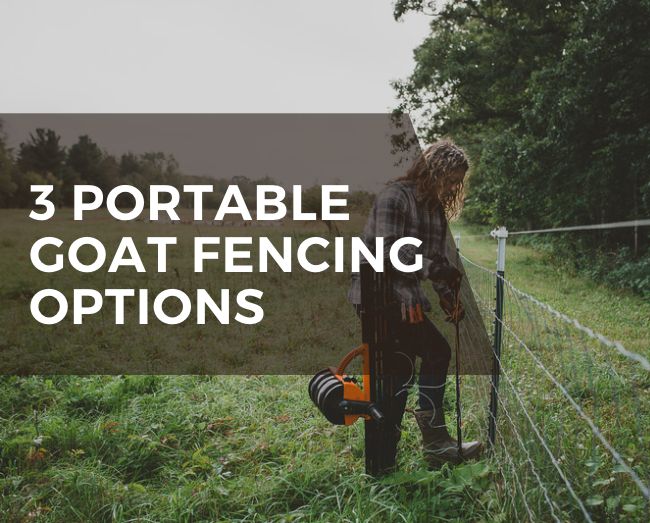At no cost to you I may earn affiliate income from links in this blog post. As an Amazon Associate I earn from qualifying purchases. I only share and promote products I actually use in my farm business.
Portable goat fencing paired with electric is an effective solution to keep goats contained, a lower-cost option, and a way to practice regenerative agriculture with rotational grazing. This post will also cover the top 3 portable goat fencing options.
Table of contents
Benefits of portable electric fence
Portable electric fencing is a flexible, affordable, and effective solution for managing goats and sheep. Here’s why it works so well—especially for beginners:
- Keeps livestock contained
While electric fencing might feel intimidating at first, it’s highly effective when used correctly. Once you understand how it works and train your goats to respect it, it becomes a reliable tool for containment. Learn how with my free Electric Fence Training Guide for Goats. - More affordable than permanent fencing
Although there’s an upfront cost, portable fencing is much less expensive than installing a permanent fence. It also saves:- Time: building it yourself or waiting to get on a contractor’s schedule
- Money: less up-front expense of building or paying for a permanent fence to be built
- Great for rotational grazing
Portable fencing makes it easy to set up temporary paddocks, which is essential for:- Practicing regenerative agriculture
- Improving pasture and soil health
- Supporting better parasite control and forage management
- Can be implemented inside existing pastures as well
- Learn more in my on-demand workshop on rotational grazing with goats.
We use all of these fencing options at our farm, Cylon Rolling Acres, depending on the season and where our goats are grazing, whether it’s woods, pasture, or hayfields.
Portable electric fencing options
There are three main portable electric fencing options for goats:
- Electric fence netting, also known as electronet: A plastic, mesh fence with spike posts, typically 50-160 feet in size. Multiple rolls can be used. I’m a big fan of Gallagher’s Sheep Net Fencing and Premier 1 Supplies Electronet 10/42/12 (affiliate link).
- Multistrand polywire with step in posts, usually set up with 2-3 strands for goats
- Smart Fence, an all-in-one-system with one reel, four strands of polywire with step in fence posts, about 300 feet in size. Multiple fences can be used together.
- If you choose to order supplies from Gallagher you can use CYLON for 10% off your entire order. I do receive a small commission at no cost to you. I’ve been using this fence for almost 8 years before I started partnering with Gallagher.

Pros and cons of portable goat fencing options
Here are the pros and cons of portable electric fences for goats:
| Portable Goat Fence Characteristics | Electric Netting | Polywire with Step in Posts | Smart Fence |
| Ease of set up and take down | Slower, may have issues with tangling | Slower, working with individual reels and posts | Quicker |
| Ease of storage or transporting | More challenging since tangling can happen | More gear, including multiple reels and posts | Easier with an all-in-one system |
| Risk of goats getting out | Less risky since there’s more of a physical barrier | More open space with 1 to 3 strands of polywire | More open space with 4 strands of polywire |
| Predator protection | Less risky since there’s a larger physical barrier with the mesh fence | Greater opportunity for crawling under the bottom wire | Greater opportunity for crawling under the bottom wire |
| Works with guard dogs | Less risky since there’s a larger physical barrier | Greater opportunity for crawling under the bottom wire | Greater opportunity for crawling under the bottom wire |
| Issues for young kids | Goat kids may risk getting tangled in the net | Goat kids can crawl under the bottom wire | Goat kids can crawl under the bottom wire |
| Estimated cost for 150 feet* | $0.99/foot | $0.49/foot + 3 reels per fence at $279.96 | $1.88/foot |
* Electric goat fence costs based on February 2023 pricing online with Gallagher Smart Fence 2, Premier 1 Supplies ElectroStop 10/42/12, single spike, and Gallagher: Turbo Wire (1640 ft roll), 10 HD Treadin Posts, and 3 standard reels.
Other equipment needed
When using portable electric fencing for goats you’ll also need other equipment beyond the fence itself:
- Electric fence charger or fence energizer
- Jumper cables or alligator cables
- Grounding rods
- Extra step in posts
- Fence checker



How to set up portable electric fence
Here’s how you’ll set up your temporary goat fencing, regardless of which option you choose:
Remove tall vegetation and brush
No matter what type of temporary goat fencing you use, you’ll need to clear a path along the fence line. This might mean mowing grass in a pasture or removing vegetation with a brush hog—or even a chainsaw if you’re working in brushy or wooded areas.
If you’re fencing in a grassy pasture or hay field, sometimes you can simply flatten the vegetation by driving over it with a four-wheeler or UTV.
Ideally, the vegetation should be cleared below the level of the bottom wire of your fence, or just under the bottom line of your electric net fencing. This helps keep your fence properly energized by reducing grounding issues and ensures the fence stays “hot,” aka effective for keeping goats contained.
Planning fence set up for paddock size
Before setting up your portable fencing, take a good look at the area you plan to graze, whether it’s pasture, woods, or another space. You’ll need to re-evaluate this regularly as you rotate your goats and set up new paddocks. Set up may be influenced by the availability of forage, the time of year, obstructions, and the size of your goat herd.
One of the easiest and most efficient setups is to use a series of “L”-shaped paddocks for rotational grazing. With three fence sections, you can create one square paddock. Once your goats graze that paddock, you can begin setting up the next “L” to form a new paddock. This way, your goats never leave a fenced-in area when transitioning between paddocks.
You’ll then take down the back fence and reuse it for the next paddock. This method works well with multiple portable fence sections and gives you flexibility based on the paddock size and available forage.
There are a number of other ways you can set up your paddocks, but this is the simplest option for getting started. To learn about more options, this article on rotational grazing covers more options.
Always, Always Train Your Goats to Electric Fence
It’s a common myth that goats will never respect a fence—electric or not. But I’m here to tell you: it is possible to use electric fencing effectively with goats. The key? Training. Yes, it takes a little time and effort, but it’s absolutely worth it.
On our farm we go through an annual training period every spring with our new goat kids and a “retraining” session for our older livestock to refresh their understanding of the fence.
The electric fence doesn’t hurt, but the shock is surprising and unpleasant, which helps train goats to stay back and respect it. If your animals aren’t trained, the fence will likely not work, and it can quickly become a frustrating—and even dangerous—tool for both you and your herd.
You can get my free Electric Fence Training Guide here. As I note in the guide:
- Always make sure the fence is on and hot.
- Ensure there’s enough forage inside the paddock for the goats to eat..
- Remove repeat fence jumpers—they’ll teach others to escape too.
We follow the same training approach with our sheep and even our livestock guardian dogs.
Temporary Fence Maintenance and Effectiveness
Temporary fences require regular upkeep, not just during setup. Here’s what to check frequently:
- Polywire that isn’t frayed
- If poly wire breaks, it’s spliced properly with a connector
- Net fencing is intact, with no broken wires
- The fence is receiving current from the energizer
- Grounding rods are installed (and enough of them)
- Voltage is high enough to manage goats
- Your energizer is powerful enough to support the number of fences connected
- The fence is always on—especially for netting (never use it as a visual barrier alone)
Need help troubleshooting? Check out my article on electric fence troubleshooting tips.
Don’t Forget an Energizer
To use portable goat fencing, you’ll need an energizer (also called a charger) to power your fence. These come in a few types:
- Plug-in (electric-powered)
- 12-volt battery
- Solar with battery backup
If you’re using portable fencing inside a pasture that already has electric fencing installed, you can “jump” to the hotwire using a jumper cable. We do this regularly when grazing inside and alongside our permanent pastures.
Learn more about energizers in this article.
Remember portable goat fencing is a temporary fence
Please note portable goat fencing is designed to be temporary! It is not intended to be permanent and should be moved fairly regularly to avoid grounding issues with the electric fence, and keep your goats contained with fresh pasture to graze, and also minimize parasite issues with your goats.
P.S. always keep the fence on!
Where to purchase fencing for goats
My two favorite retailers for goat and sheep fencing supplies are Premier 1 Supplies and Gallagher.
We’ve been using Gallagher products from the very start with our energizers and portable fencing. I’m proud to be a Gallagher partner and also share with you a 10% discount code – CYLON – on your entire order on the Gallagher NA website, for orders in the U.S. and Canada (affiliate link).
This article was first published in May 2023, and was updated most recently, May 2025.
FAQs about portable fence
On our farm we use the portable fencing for rotational grazing. We are moving the fence every 1-3 days to a new paddock as a feed source for the goats. In short, grazing like this is a great for the animals since it’s helping reduce parasite issues, it encourages increased forage production in your pastures, and it’s good for soil health.
There are ways to use movable fence longer term, but you need to watch out for grounding issues with grass growth and make sure there’s enough pasture as a feed source for your goats. If they don’t have enough to eat they will find a way to get out of the fence to get food.

[…] Three portable goat fencing options […]